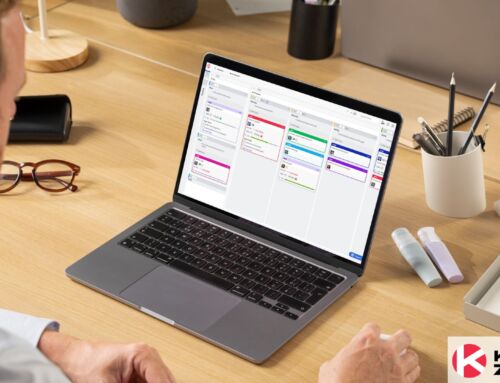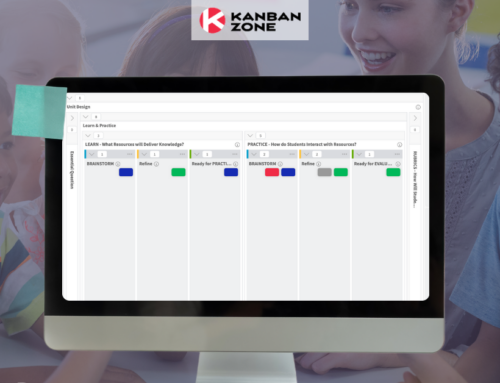
We are all in search of the perfect productivity system. Good time management, task organization, and careful planning are key to achieving success and reaching our goals. While a perfect system does not exist, there is one particularly simple, yet very helpful and effective methodology which users can utilize for all your needs. Whether you are looking to organize personal tasks and errands or want to up your business game, using it can help you get a better overview of everything that needs to be done, and allows you to plan for successful execution. But what is Kanban?
What is Kanban?
It is a lean manufacturing technique, which over time, matured into one of the more prominent visual project management methodologies. It is based on a visual system – the board – for managing work as it moves through a process. By using boards for visualizing both, the process and the actual work, team members can see the status of every work segment at any time.
It greatly relies on real-time communication of capacity and full transparency of work and aims to identify potential bottlenecks in the process and ways to fix them, in order to make workflow continuous and cost-effective, at an optimal speed and/or quantity.
Short History of Kanban
The methodology of work dates back more than 50 years. The system was first created and implemented in the late 1940s in Toyota automotive in Japan by Taiichi Ohno. It was designed as a simple planning system that would help control, manage and optimize work and inventory during each stage of the production. The goal was to better align their massive inventory levels with the actual consumption levels.
The main reason for creating it was the inadequate productivity and efficiency of Toyota compared to its American automotive rivals. By implementing it, Toyota achieved a flexible and efficient just-in-time productions control system which increased their productivity, while at the same time, reduced their cost-intensive inventory.
Kanban Method: Principles and Practices
Even though it does not rely on very strict rules or limitations, it relies on a set of principles and practices. These principles serve as guidelines for proper use and implementation of the method, and their practical application leads to reaping numerous benefits.
The Kanban Method
The method was initially introduced in the manufacturing industry, and years later, in 2004, the concept was applied in IT, Software development and knowledge work in general by David J. Anderson. He built on the works by Taiichi Ohno, Eli Goldratt, Edward Demmings, Peter Drucker and others to define it and its concepts. To this day, his first book on it – “Kanban: Successfully Evolutionary Change for your Technology Business”, published in 2010, is the most comprehensive definition of the Method.
It defines the approach to incremental, evolutionary change, and uses a work-in-progress limited pull system at its core to expose system operation or process problems and stimulate collaboration to improve the system. Therefore, this method can be applied in any business and gradually improve whatever you do – Software development, IT, Marketing and Sales, Recruitment, Procurement, etc.
The Method follows a set of principles and practices for managing and improving the flow of work. Due to its non-disruptive nature, it supports the introduction to evolutionary gradual changes that are meant to improve the processes inside an organization. If you follow and apply them to your current workflow, you will be able to successfully use the method and maximize the benefits to your business processes.
Basic Kanban Principles
The Method relies on four foundational principles. These main principles depict the whole philosophy behind it and guide the application and use of the framework. If you don’t respect one of the principles, you are not using the method properly.
1. Start with what you are doing now
It emphasizes not making any changes to your existing process straight away. The process must be applied directly to the workflow, as is it at the moment. Any changes that would be made should happen gradually, over a certain period of time and at a pace that will be comfortable for the team.
2. Agree to pursue incremental, evolutionary change
Making changes while using it means making small incremental alterations rather than radical ones because that may lead to resistance and conflicts within the team and the organization. Small changes allow for easier adaptation and a smoother transition to the new processes.
3. Initially, respect current roles, responsibilities, and job-titles
To implement it, you don’t need to make organizational changes. You can just apply the method. Existing roles and functions that perform well do not need to be changed; instead, the team should collaboratively identify and implement the necessary changes.
4. Encourage acts of leadership at all levels
Part of it is encouraging leadership at all levels of the organization. People at all levels can and should voice their ideas. By showing leadership and implementing change they will help continually improve the organization’s internal and external processes, products and services.
Core Practices of Kanban
Along with the set of principles, it also has a set of core practices, which support the successful implementation of the whole methodology, optimization of the workflow and more efficient resource use and planning. The core practices are:
#1 Visualize the Workflow
The first and fundamental step towards adopting and implementing Kankan is visualizing the workflow. It helps better understand what it takes to get a task from request to completion. It’s main goal is to make changes that will optimize the flow of work through the system. Only after you understand the process, you can make improvements.
One of the most common ways to visualize the workflow is by using a physical or digital Board with columns. Each column on the board represents a different step in the workflow. After you define the process, you can visualize the current work the team is doing. It can be in the form of stickers or cards with different colors to represent different services or different types of work.
Depending on the complexity of your process and work scope, the Board may be very simple or very elaborate. If you find it useful, your board can have different Swimlanes for each class of service or work type, or just one to manage all your work. There is no right way to categorize your requests or one right workflow. The initial design of your board is not final. You can go back to the board and redesign it later to reflect a workflow that suits your team the most.
#2 Limit Work in Progress (WIP)
Limiting work-in-progress (WIP) is fundamental to implementing a pull system on all or parts of the workflow. Limiting the scope of elements that are WIP at each state in the workflow encourages the team to complete the work at hand first in order to create capacity in the system. Then, after completing and marking work as done, new work is “pulled” in by the team.
At first, it may be difficult to define your WIP limit. That is why you may begin without WIP limits and simply observe the initial work in progress as your team begins to use Kanban. Once you see how the workflow moves from stage to stage, define WIP limits for each stage – each column of the Kanban board. It’s recommended that you take half of what you observed to be the average WIP.
Putting limits to WIP on each column of the board can be helpful for team members to be more focused and first finish what they are doing before taking on new tasks and assignments. Additionally, it communicates to customers and other stakeholders that there is a limited capacity of work each team can do and they need to plan carefully what the team needs to do next.
#3 Manage Flow
The overall point of implementing Kanban is creating a positive change. In order to create that change, you need to identify possible areas of improvement. After implementing the first two practices, you can continue observing how value is currently flowing through the system, analyze problem areas in which value flow is delayed, then define and implement changes.
The Kanban system helps in workflow management by highlighting the different stages of the workflow and status of work in each stage. A well-defined workflow and realistically set WIP limits to help see how quickly work moves from start to end, and whether tasks pile up and hold up capacity. By having a visual representation, the team can analyze the system and make adjustments to specific parts of the process that will help reduce the time it takes to complete each task.
The key aspect of the process of observing the workflow and eliminating or resolving bottlenecks is to look at the more advanced waiting stages and note how long the work stays in the handoff stages. Reducing the time spent in these waiting stages plays an important role in reducing the overall Cycle time. As you implement improvements, the team’s delivery becomes smoother and more predictable. Thus, it becomes easier to make reliable commitments to customers and stakeholders. Lastly, it helps improve forecasting completion times, which is a big part of implementing Kanban.
#4 Make Process Policies Explicit
In addition to visualizing the process, it is advised you visualize your policies, process rules and guidelines for how you do the work too. By formulating them clearly, you allow all participants to understand how to do any type of work in the system. Policies can be defined at a broad level, at a swim lane level, and for each separate column. They should be explicitly stated and visualized on top of the board and on each lane and column.
#5 Implement Feedback Loops
Feedback loops have a key role in every good system. Kanban supports the implementation of feedback loops and uses four specific practices for feedback: the standup meeting, the service delivery review, the operations review, and the risk review. The purpose of feedback loops is to provide information and compare expected against actual outcomes, then make adjustments.
The goal is to get a better understanding of the current processes and outcomes in comparison with the expectations in the early development phases, especially if the work is on the wrong track. It is crucial to make adjustments and deliver the right work, product or service to the customer in the shortest possible time.
#6 Improve Collaboratively, Evolve Experimentally
Kanban is an evolutionary improvement process which allows teams to adopt small changes and improve gradually at pace and scale which are most comfortable. It encourages the use of a scientific method – forming a hypothesis and testing it, then making changes based on the outcomes of the tests.
When a team is implementing Agile principles, their key task is to constantly evaluate and improve their processes. After a change is implemented, the outcome can be observed, measured and examined using the signals the Kanban system provides. Using the signals, the change can be evaluated, and the team can determine whether it is helping them improve or not, and decide whether to continue or try something different.
What is Kanban Board and How to Use it
As we mentioned, this methodology is basically a visual system. And as such, it heavily relies on the use of two specific tools which allow for better processes, tasks and resources visualization, and their optimal planning and utilization – the Kanban Board and Kanban cards. Let’s explore what they are and how to use them.
The Kanban Board
A Kanban board is the main visualization tool for implementing Kanban in the organization. The Kanban board is used by all teams for visual representation and management of their work and improving the delivery processes in terms of quality, predictability and time-to-market performance.
The board can be physical or electronic. It consists of one or more so-called “swim” lanes and multiple columns that are used to depict the workflow process, often referred to as “Value Stream”. Regardless of whether the team is using a physical or digital board, it represents a “virtual Kanban system” of the team’s workflow and it ensures all work is standardized, and all blockers and dependencies are immediately identified and resolved.
The most basic Kanban board has a three-step workflow, represented with three columns – To Do, In Progress and Done – which the team populates it with cards that represent work items of different types. Depending on the team’s size, structure, and objective, the workflow can be adapted to resemble the process the team uses. The board can also have one or multiple lanes, which are used to separate different types of work that might have different workflows.
Working with a Kanban Board
Most simply put, working with Kanban is done by pulling cards on the board then moving them through the various stages of the work process defined on the board. Cards are stored in the Backlog and get pulled on the board according to the available capacity of work. The pace at which cards get pulled on the board depends on the context of the work and speed with which tasks are completed.
Depending on your process, each card passes through multiple stages, being placed from one column to the next, until the full workflow is completed. The Kanban system is very flexible. It is very easy to map out your specific process on the board and use it to manage the flow.
To ensure successful implementation of this system, the team needs to define Work-In-Progress (WIP) limits and how to enforce those limits. You may start with no WIP limits, and later, when you have sufficient data, define them for each stage of the workflow. You may additionally choose to either stay within limits or allow them to be exceeded in special circumstances. This way, Kanban helps you have a smooth flow of work without a buildup of an excessive workload at any stage of the process.
Kanban Cards and Their Purpose
Kanban in Japanese literally means “visual sign”. Each Kanban card, or simply Kanban, represents a task or a work item, which requires a certain capacity to be completed. The Kanban cards usually are colored differently to represent different work items or types of services. They are hierarchical by nature allowing you to model them according to your project-specific needs. You can break down the main project requirements into project cards, then furthermore, you can decompose each project card into smaller separate tasks.
The main purpose of Kanban cards on the board is to allow the team members to keep visual track of the progress of work. Cards also store the feature critical information about particular work items. They provide the team full visibility into who is responsible for the work, a short description of the task, estimated time it takes to complete the work, etc. Often, cards include screenshots, actual work files, and other technical details. This way, the team will have full access to every work item at any moment, along with its associated details, which ensures increased focus, full traceability, and fast identification of blockers and dependencies.
The Future of Kanban
The Kanban framework is simple and easy to understand visual tool that eliminates a lot of unnecessary communication and drastically accelerates the organization’s feedback loops. Additionally, it is designed to be fully flexible. It has a small set of rules and no formal team guidelines, which makes it a perfect addition to the existing organizational processes.
This framework was reintroduced by the software development industry less than 10 years ago. Now, thanks to its popularity in the IT sector, we can see many companies from other verticals adopting the lean and Agile methods as well. The emergence of Kanban software is also supporting its adoption. When projects are digitally visualized, teams have a better overview of the tasks, can communicate and share documents and notes more easily, and work more intelligently on complex problems. This tried-and-tested approach shows that sometimes simple is truly the best, so it wouldn’t be a surprise if this methodology becomes the new project management standard.
Learn to Work Smarter, Not Harder!
Get our top articles weekly.
Table Of Contents
Discover many more posts…






